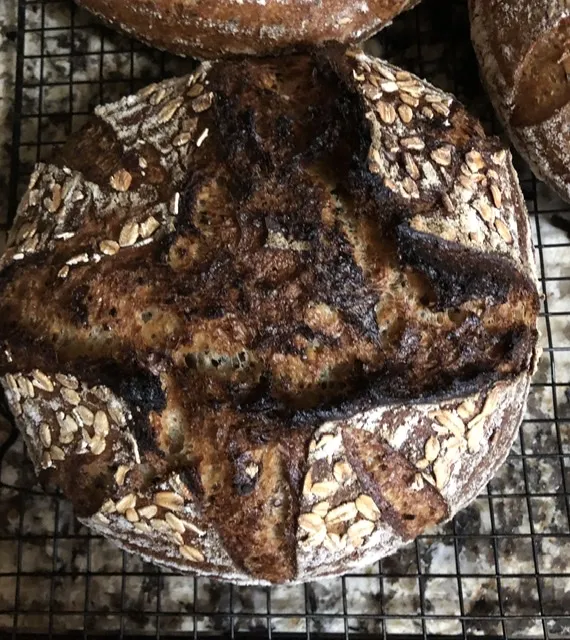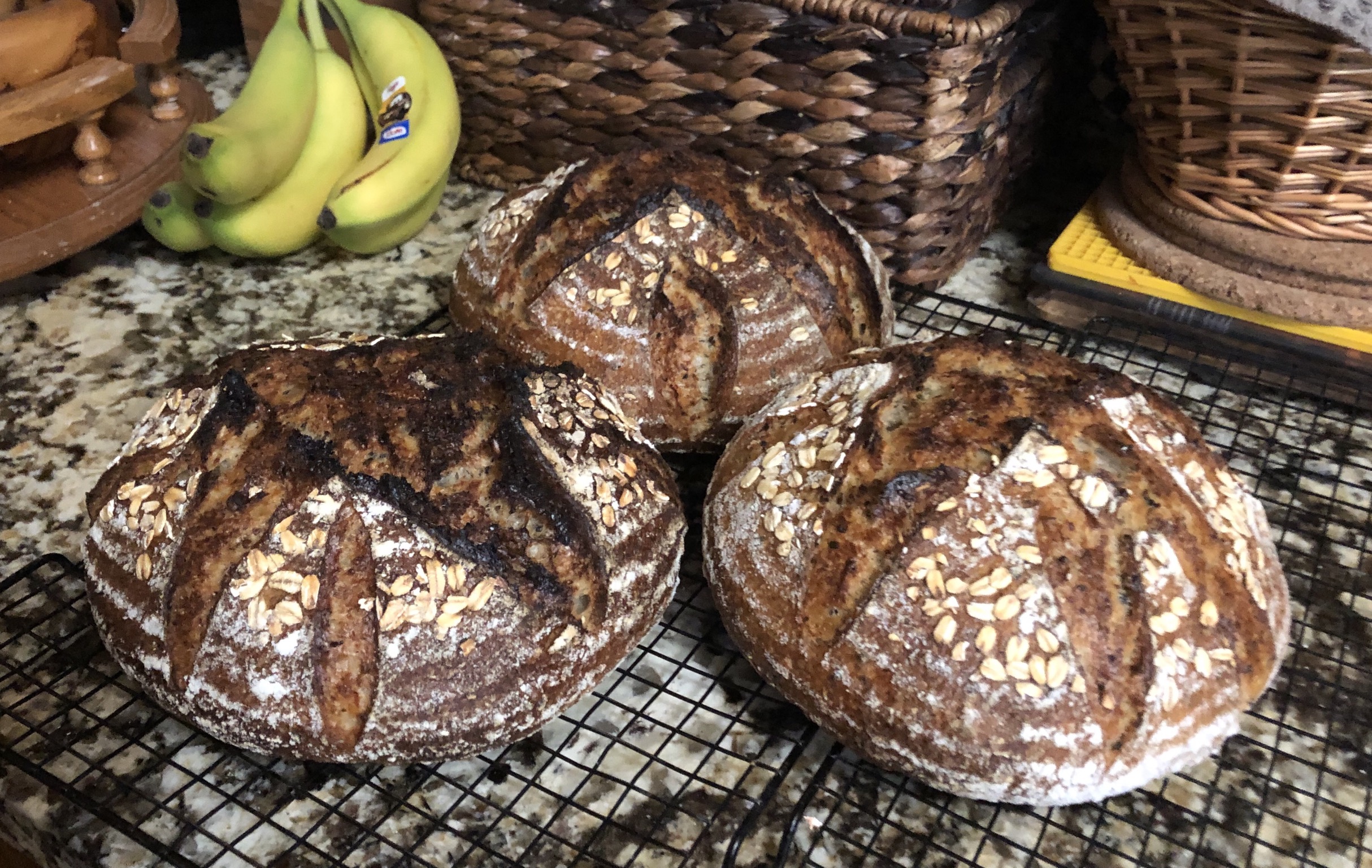
This is a rare mid-week bake of a single batch that gives 3 loaves. What prompted this? James (aka Ciabatta) produced 12 loaves of 4 (Yes! Four!) different breads. His streamlined method piqued my interest so I decided to give it a shot since it I think it would shorten my dough making time significantly. So here goes:
Recipe
Makes 3 loaves
Porridge
100 g rolled oats
200 g water
45 g honey
40 g butter
Add-ins
25g raw Black Sesame seeds
45g raw Sunflower seeds
35 raw hemp hearts
Dough
700 g unbleached flour
200 g freshly milled Red Fife flour (Red Fife berries)
100 g freshly milled Rye flour (Rye berries)
50 g flax, freshly ground
30 g yogurt
600 g filtered water + 25 g + 25g + 25 g
22 g salt
250 g levain (procedure in recipe)
The morning before:
- Take 2 g of refrigerated starter and feed it 4 g of filtered water and 4 g of any kind of wholegrain flour. Let sit at room temperature about 6 hours.
The afternoon before:
- Feed the levain 20 g of water and 20 g of wholegrain flour. Let that rise at cool room temperature for another 6 hours.
The night before:
- Mill the Red Fife and rye berries. Place the required amounts of Red Fife and Rye flour in a tub, and add the unbleached flour to it.
- Grind the flax seeds in a bullet and add to the tub. (I added the salt too at this time). Cover and set aside.
- Add the water to the rolled oats and cook on medium low until very creamy, then add the butter and the honey. Stir well and put into the fridge for the night.
- Toast the sesame and sunflower seeds along with the hemp hearts in a dry frying pan or in the oven at 350 F. They are done when lightly golden and fragrant. Reserve.
- Before bed, feed the levain 100 g of filtered water and 50 g of whole grain flour and 50 g of unbleached flour. Let rise overnight until doubled.
Dough Making day:
- In the morning, when the levain is nice and bubbly, put the filtered water in a stand mixer’s bowl and add the levain, the flours from the tub, and the salt if it’s not in the flour mix already, as well as the porridge. Mix on the lowest speed until all the flour has been hydrated and everything is homogeneous. This takes about 4 - 5 minutes. Place dough in a lightly oiled tub. Once I got the dough into the tub, I felt it was a bit tight so I added 25 g water to be absorbed during the folds. Let the dough rest for 45 minutes in a warm spot (oven with the light on and the door cracked).
- Give the dough a coil fold, add the next 25 g of water (dough still felt tight), and let rest another 45 minutes.
- Dimple the seeds into the dough and give it another set of coil folds. Add another 25 g of water. Let rest 45 minutes.
- Do another two sets of coil folds 45 minutes apart until the dough has developed enough to give a windowpane.
- Let the dough rise to 30%. This only took another 30 minutes. The dough already was at 30% at the last fold but I decided it needed one more to strengthen it.
- Tip the dough out on a bare counter, sprinkle the top with flour and divide into portions of ~830 g. Round out the portions into rounds with a dough scraper and let it rest 15 minutes.
- Do a final shape by flouring the rounds and flipping the rounds over on a lightly floured counter. Gently stretch the dough out into a circle. Pull and fold the third of the dough closest to you over the middle. Pull the right side and fold over the middle and do the same to the left. Fold the top end to the center patting out any cavities or big bubbles. Finally stretch the two top corners and fold over each other in the middle. Roll the bottom of the dough away from you until the seam is underneath the dough. Cup your hands around the dough and pull towards you, doing this on all sides of the dough to round it off. Finally spin the dough to make as tight boule as you can.
- Sprinkle half rice/half AP flour in the bannetons. I also sprinkled some rolled oats in there. Place the dough seam side down in the bannetons. Cover with plastic bowl cover or shower caps. Let rest for a few minutes on the counter and then put to bed in a cold (38F) fridge until the next day. (I actually baked these at midnight since I had started so early in the morning and they had proofed in the fridge for 10 hours by then.)
Baking Day
- The next morning, heat the oven to 475F with the Dutch ovens inside for 45 minutes to an hour. Then take the loaves out of the fridge.
- Turn out the dough seam side up onto a cornmeal sprinkled counter. (For fun, since I only had 3 loaves, I scored them.) Place rounds of parchment paper in the bottom of the pots, and carefully but quickly place the dough seam side up inside.
- Cover the pots and bake the loaves at 450 F for 25 minutes, remove the lids, and bake for another 22 minutes at 425 F. Internal temperature should be 205 F or more.
I wonder if I should have skipped the scoring as my loaves were quite a bit flatter than what I usually get. They also baked up quite dark and crunchy. I’m quite impatient to see the crumb.
I really like that James’ method cut quite a bit of dough making time but I think I need to do a few more bakes to get loaves as nice as his.

- Danni3ll3's Blog
- Log in or register to post comments
If you just showed me a photo of these loaves I don’t think I would have known they were baked by you Danni. They are missing your signature random breaks in the crust from the oven spring absent scores. Not that your scoring isn’t great, but I don’t associate scoring with Danni bakes. Other than that, you got me at black sesame seeds. ?
I don’t know if that was a smart choice as they came out rather flat. I haven’t cut into one yet.
Those are unmistakably danni3II3 loaves for sure. Bold and pretty. Must be a whirlwind flavor circus as well.
But I wonder about "Let rise overnight until doubled". My starter would have risen, doubled and collapsed well before the sun rose on dough mixing day. Perhaps you're a nightowl and mix your levains at 1 or 2 am. If not, could an overripe levain have contributed to your low profile loaves? In my limited experience with it, Red Fyfe is the Unholey Anti-Crumb -- more experiments scheduled for this winter when I have more time and can control fermentation better. And of course rye doesn't do any favors there either. Have I asked you this before (seems perhaps I have): Is the yogurt for dough strength? If so, have you tested + and – to confirm or not that it actually delivers on that front? And what's up with hemp hearts, besides a cute and kind name? Flavor? Fiber?
Thanks for the inspiration, as always.
Tom
I think I fed the levain around 1:30 am and I was using it by 9 am. It was fine.
The yogurt is to tenderize the crust. I had people complain it was too chewy and the fat in the yogurt helps make it more tender. I believe the crust is a bit thinner too. I guess you could use any fat to obtain the same results but our local dairy makes a great full fat yogurt and you don’t need a lot. I just stumbled into this practice when I needed to use some up years ago.
Hemp hearts: Nutrition mostly. They look cute and I like variety. And why not!
Love the color of those loaves! Now you've inspired me to try seed porridge. Does your oven fit all 3 dutch ovens? must be a big oven.
I can imagine how fragrant the bread must be with the freshly milled berries and ground flaxseed. I'm not milling yet. but that's definitely something i eventually want to do.
I've found that when i use flaxseed meal, the fermentation slows way down. something about the oil in the flax that delays fermentation and gluten development.
Your loaves look great and very interesting/functional scoring. Love it. Any photos of the crumb?
James
3 on the top shelf and 3 on the bottom shelf. It’s a regular 30 in oven. I do have to jury rig the bottom shelf in that it sits on the curve at the bottom of the oven rather than the lugs. Since the bottom has a hidden element, the bottom shelf sits about about an inch or so from the floor. When baking six loves, i switch the pots from top to bottom and vice versa when it’s time to take the lids off. I have a hot spot in the front right hand corner and keep the pots away from that. Pots are 3 quart dutch ovens. Since they were cheap and enameled, they are looking pretty worn these days so I’m looking for plain 3 quart cast iron replacements if the same size but it’s like looking for a dodo bird.
Interesting comment about the flax seed. I’ve never noticed that at all. I grind it very finely so maybe that helps? Oh and never put flax in your flour mill. I use a bullet mixer for that.
Crumb picture will be tonight. I had to finish another loaf first before we cut into this one.
It’s not too bad:
No idea why my pictures are sideways.
Your photos maybe sideways but your bread is always spot on. The crumb is wonderful, I cannot imagine any better for a seeded porridge loaf!
Benny
nutritious, gorgeous and packed with goodies as ever! Just beautimous!
Happy baking Danni
Great baking. Always interesting to try new methods and adjust to make it work for you.